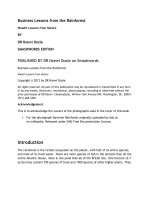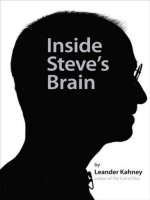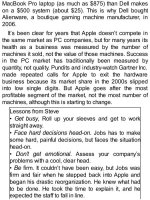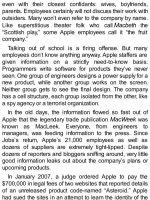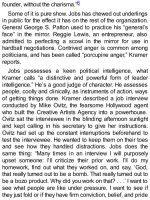Inside Steve''''s Brain Business Lessons from Steve Jobs, the Man Who Saved Apple by Leander Kahney_3 pdf
Bạn đang xem bản rút gọn của tài liệu. Xem và tải ngay bản đầy đủ của tài liệu tại đây (135.23 KB, 25 trang )
MacBook Pro laptop (as much as $875) than Dell makes
on a $500 system (about $25). This is why Dell bought
Alienware, a boutique gaming machine manufacturer, in
2006.
It’s been clear for years that Apple doesn’t compete in
the same market as PC companies, but for many years its
health as a business was measured by the number of
machines it sold, not the value of those machines. Success
in the PC market has traditionally been measured by
quantity, not quality. Pundits and industry-watch Gartner Inc.
made repeated calls for Apple to exit the hardware
business because its market share in the 2000s slipped
into low single digits. But Apple goes after the most
profitable segment of the market, not the most number of
machines, although this is starting to change.
Lessons from Steve
• Get busy, Roll up your sleeves and get to work
straight away.
• Face hard decisions head-on. Jobs has to make
some hard, painful decisions, but faces the situation
head-on.
• Don’t get emotional. Assess your company’s
problems with a cool, clear head.
• Be firm. It couldn’t have been easy, but Jobs was
firm and fair when he stepped back into Apple and
began his drastic reorganization. He knew what had
to be done. He took the time to explain it, and he
expected the staff to fall in line.
• Get informed; don’t guess. Make a thorough
inspection of the company and base your decisions
on data, not hunches. It’s tough but fair.
• Reach out for help. Don’t shoulder the burden
alone. Jobs asks for the company’s help, and he gets
it. The managers help shoulder the burden of any
cuts.
• Focus means saying “no.” Jobs focuses Apple’s
limited resources on a small number of projects it can
execute well.
• Stay focused; don’t allow feature creep. Keep
things simple, which is a virtue in a world of overly
complex technology.
• Focus on what you are good at; delegate all else.
Jobs doesn’t direct animated movies or woo Wall
Street. He concentrates on what he’s good at.
Chapter 2
Despotism: Apple’s One-Man Focus
Group
“We made the buttons on the screen look so good
you’ll want to lick them.”
—Steve Jobs, on Mac OS X’s user interface, Fortune, January 24,
2000
Before Jobs returned to Apple, the company had spent
several years fruitlessly trying to develop a modern version
of the Macintosh operating system. Since its debut in 1984,
the old Mac OS had turned into a bloated, unstable
patchwork of code. It had become a nightmare to maintain
and upgrade. For users, it meant constant crashes,
freezes, and restarts—and lots of lost data, frustration, and
rage.
Because large portions of the Mac OS were still based
on creaky old code, Apple decided that it had to start from
scratch. In 1994, programmers began a ground-up rewrite
of the operating system, code-named Copland, after the
famous American composer. But after a couple of years of
effort, it became apparent the project was a gargantuan
effort and would never be finished. The Apple executive
team at the time decided it would be easier (and wiser) to
purchase a next-generation operating system from another
company rather than develop one itself. The search
eventually led to the purchase of Steve Jobs’s NeXT.
Apple was interested in NeXTstep, a surprisingly
advanced and sophisticated operating system that Jobs
had developed during his wilderness years away from
Apple. NeXTstep had everything the old Mac OS lacked. It
was fast, stable, and almost crash-proof. It had modern
networking features— essential in the Internet age—and a
modular architecture that was easily modified and
upgraded. It also came with a collection of great
programming tools, which made it very easy for software
developers to write programs for it. Programming tools are
a huge competitive advantage in the tech industry.
Computer platforms are doomed unless they can attract
talented programmers to create applications for them, just
like game consoles are doomed unless they can attract
great games. From the Mac to the Palm Pilot and the Xbox,
the success of a platform is primarily determined by the
software that can run on it. In some cases this is the so-
called killer app—an essential piece of software that
guarantees the success of the platform, like Office on
Windows, or the game Halo on the Xbox.
What’s NeXT?
After buying NeXT, Apple had to figure out how to turn
NeXTSTEP into a Macintosh operating system. At first, the
job looked so big that Apple’s programmers decided they
should take the old interface in Mac OS 8 and try to graft it
on top of the NeXTSTEP codebase. According to Cordell
Ratzlaff, the manager who was charged with overseeing the
job, the interface graft didn’t look like it would present much
of a challenge. “We assigned one designer to OS X,” he
recalled. “His job was pretty boring: make the new stuff look
like the old stuff.”
But Ratzlaff thought it was a shame to put an ugly façade
on such an elegant system, and he soon had designers
creating mockups of new interface designs. Ratzlaff told
me that the mockups were designed to show off many of
the advanced technologies under NeXTstep’s hood—
especially its powerful graphics and animation
capabilities.
1
Ratzlaff, a soft-spoken creative director for Frog Design,
a storied and internationally famous design company,
worked at Apple for nine years. Starting as a designer, he
rose through the ranks to lead the human interface group
for Mac OS. In this role, Ratzlaff was in charge of the look
and feel of Apple’s operating systems from Mac OS 8
through the first release of OS X.
Interfaces these days are colorful and dynamic, but in the
late 1990s, both Apple’s and Microsoft’s operating
systems were plain and gray, with boxy windows, sharp
corners, and lots of bevels. Then Apple came out with the
tear-shaped iMac, a computer with a transparent plastic
shell and curvy organic lines. It was a big inspiration to
Ratzlaff and his colleagues. They soon had mockups of
colorful, airy interfaces with see-through menus, soft edges,
and round, organic buttons.
Ratzlaff’s boss, Bertrand Serlet, now Apple’s senior vice
president of software engineering, admired the mockups
but he made it clear there was neither the time nor
resources to implement them. OS X’s lone designer
continued to graft the old Mac interface onto NeXTstep.
After several months of work, Apple held an off-site for all
the engineering groups working on OS X to gather a status
report. Ratzlaff was asked to show his mockups, mostly just
for kicks. His talk would be some light relief at the end of a
long, hard week. He was scheduled as the last speaker on
the last day. But he secretly hoped there’d be support for
the new designs and they’d be implemented, although he
didn’t rate his chances. As the two-day event wore on, it
became clearer and clearer what an enormous project OS
X was. Everyone was wondering how it was ever going to
get done. “And then here at the end, here’s me saying, ‘Oh,
and here’s a new user interface. It’s translucent, there’s
real-time animation, and a full alpha channel,’ ” Ratzlaff
recalled. “There was literally laughter in the room because
there was no way we were going to redo the user interface.
I was pretty depressed afterwards.”
“You’re a Bunch of Idiots”
Two weeks later Ratzlaff got a call from Steve Jobs’s
assistant. Jobs hadn’t seen the mockups at the off-site—he
hadn’t attended—but now he wanted a peek. At the time,
Jobs was still conducting his survey of all the product
groups. Ratzlaff and his designers were sitting in a
conference room waiting for Jobs, when he walked in and
immediately called them “a bunch of amateurs.”
“You’re the guys who designed Mac OS, right?” he asked
them. They sheepishly nodded yes. “Well, you’re a bunch of
idiots.”
Jobs rattled off all the things he hated about the old Mac
interface, which was just about everything. One of the things
he hated most were all the different mechanisms for
opening windows and folders. There were at least eight
different ways of accessing folders—from dropdown menus
to pop-up menus, the DragStrip, the Launcher, and the
Finder. “The trouble was, you had too many windows,” said
Ratzlaff. “Steve wanted to simplify window management.”
Because Ratzlaff was the one primarily responsible for
these features, he started to get nervous about his job, but
after twenty minutes of withering criticism, Ratzlaff realized
his position was probably safe. “I figure he’s not going to
fire us, because that would’ve happened already,” Ratzlaff
said.
Jobs, Ratzlaff, and the designers settled into an in-depth
discussion of the old Mac interface and how it might be
overhauled. Ratzlaff’s team showed Jobs their mockups
and the meeting wrapped up well. “Prototype these things
and show them to me,” Jobs instructed them.
The design team worked for three weeks, night and day,
building working prototypes in Macromedia Director, a
multimedia authoring tool often used for mocking up
custom interfaces for software or websites. “We knew our
jobs were on the line so we were pretty worried,” he said.
“He [Jobs] came over to the offices. We spent the whole
afternoon with him. He was blown away. From that point on,
it was clear there was going to be a new user interface for
OS X.”
Jobs was so impressed that he said to Ratzlaff: “This is
the first evidence of three-digit intelligence at Apple I’ve
seen yet.” Ratzlaff was happy to take the compliment. For
Jobs, acknowledging you have an IQ higher than 100 is a
glowing endorsement. Confident that their jobs were safe,
Ratzlaff and the designers celebrated with a few six-packs
of beer. But they became nervous when they saw Jobs
coming back down the corridor with Phil Schiller, Apple’s
head of marketing. Luckily, Jobs was pleased. As Jobs
approached, they heard him tell Schiller excitedly, “You’ve
got to see this.”
“From then on we had no trouble,” Ratzlaff said.
No Detail Too Small
For the next eighteen months, Ratzlaff’s team had a weekly
meeting with Jobs during which they’d show him their latest
mockups. For each element of the new interface—the
menus, the dialogs, the radio buttons—Jobs requested
several variations so that he could select the best ones. As
we’ll see in more detail later, Jobs always asks for multiple
variations of products in development—both hardware and
software. During the meetings with Ratzlaff, Jobs gave lots
of feedback for refining the designs, and only when he was
satisfied could features be ticked off.
The design team’s mockups, in Macromedia Director,
were dynamic, but they weren’t functioning software. Jobs
could open and close windows, pull down menus, and see
how the system would work. But they were only animations.
They weren’t working code. The team had the working
code running on another machine that was placed next to
the Director demo. When they showed the working code to
Jobs, he’d lean forward, his nose to the screen, and
examine them closely, moving from the demo to the
prototype and back again.
“He would compare them pixel by pixel to see if they
matched,” Ratzlaff said. “He was way down into the details.
He would scrutinize everything, down to the pixel level.” If
they didn’t match, Ratzlaff said, “some engineer would get
yelled at.”
Incredibly, Ratzlaff’s team spent six months refining the
scrollbars to Jobs’s satisfaction. Scrollbars are an
important part of any computer operating system but are
hardly the most visible element of the user interface.
Nonetheless, Jobs insisted the scrollbars look just so, and
Ratzlaff’s team had to design version after version. “It had
to be done right,” said Ratzlaff, laughing at the effort that
went into such a seemingly minor detail.
At first, the design team found it very difficult to get the
scrollbar details true. The little arrows were the wrong size,
or in the wrong place, or the color was off. The scrollbars
had to look different if the window was the currently active
window or one of the background windows. “It was pretty
hard to get them to fit with the rest of the design in all these
different states,” Ratzlaff said with a note of weariness in
his voice. “We kept at it until it was right. We worked on it
for a long, long time.”
Simplifying the UI
OS X’s interface was designed with new users in mind.
Because the system would be new to everyone—even
veteran Mac users—Jobs focused on simplifying the
interface as much as possible. For example, in the old Mac
OS, most of the settings that determined system behavior
were hidden away in myriad System Extensions, Control
Panel menus, and special dialog boxes of the various
system components. Setting up an Internet connection used
to involve tweaking settings in up to half a dozen different
places.
To simplify things, Jobs ordered as many settings as
possible to be collected together into a single System
Preferences box that lived in a new navigation element
called “The Dock.” The Dock is an icon-filled bar that sits at
the bottom of the screen. It is home to commonly used
applications and the system trashcan. It can accommodate
all kinds of stuff, from frequently used folders to mini-
programs called “scripts.”
Jobs insisted on stripping back as many interface
elements as possible, maintaining that the content of the
windows were the most important thing, not the windows
themselves. His desire to strip back and simplify put an end
to several major features, including a single-window mode
that the design team worked on for many months.
Jobs hated having multiple windows open. Every time a
new folder or document was opened, it spawned a new
window. Quickly, the screen was filled with overlapping
windows. So the designers created a special single-
window mode. Everything was displayed in the same
window, no matter which software program the user was
working in. The window would display a spreadsheet, then
a text document or a digital photo. The effect was rather
like jumping from website to website in a single web
browser window, except here it was between documents
stored on the local hard drive.
Sometimes the system worked well, but the window often
had to be resized to display different kinds of documents.
When working with a text document, the window was best
made thin and narrow to make it easy to scroll up and down
the text. But if the user opened an image in landscape
format, the window would have to be widened.
But this wasn’t the biggest problem. Critically for Jobs,
the system required the designers to create a dedicated
button in the window toolbar to switch it on and off. Jobs
decided, in the interest of simplicity, to take the button
away. He could live with resizing windows, but not the
additional button cluttering the menu bar. “The extra button
wasn’t justified by the functionality,” Ratzlaff said.
While working on the new interface, Jobs would
sometimes suggest what at first seemed to be crazy ideas,
but later turned out to be good ones. At one meeting, he
was scrutinizing the three tiny buttons in the top left corner
of every window. The three buttons were for closing,
shrinking, and expanding the window, respectively. The
designers had made all the buttons the same muted gray,
to prevent them from distracting the user, but it was difficult
to tell what the buttons were for. It was suggested that their
functions should be illustrated by an animation that was
triggered when the mouse cursor hovered over them.
But then Jobs made what seemed like an odd
suggestion: that the buttons should be colored like traffic
stoplights: red to close the window, yellow to shrink it, and
green to expand it. “When we heard that, we felt that was a
strange thing to associate with a computer,” Ratzlaff said.
“But we worked on it for a little while and he was right.” The
color of the button implicitly suggested the consequence of
clicking it, especially the red button, which suggested
“danger” if the user clicked it but didn’t mean to close the
window.
Introducing OS X
Jobs knew that OS X would cause a huge outcry from
Apple’s outside software developers, who would have to
rewrite all their software to run on the new system. Even
with OS X’s great programming tools, there would be
pushback from developers. Jobs and his executives
struggled with the best way to approach the software
community. Eventually they came up with a strategy: if they
could persuade just three of the biggest companies to
embrace OS X, everyone else would follow. The big three
were Microsoft, Adobe, and Macromedia.
It worked—eventually. Microsoft supported OS X from
the get-go, thanks to Jobs’s 1998 deal with Bill Gates that
cemented five years of software support. But Adobe and
Macromedia weren’t so quick to convert their big
applications like Photoshop and Dreamweaver. Both
companies eventually ported them over, but they refused to
rewrite their consumer applications for OS X, a decision
that led Apple to develop its own application software and,
indirectly, the iPod (more on this later).
While it was no secret Apple was working on OS X, the
fact that it had a new interface was. The interface was
designed in intense secrecy. Very few people at Apple
even knew the interface was being overhauled, only the
handful of people working on it. One of Jobs’s stated
rationales for keeping it secret was to prevent others—
Microsoft in particular—from copying it.
But more important, Jobs didn’t want to kill sales of the
current Macintosh operating system. Jobs wanted to avoid
what’s known as the Osborne effect, where a company
commits suicide by announcing cool technology still under
development.
As soon as OS X development started, Jobs directed
everyone at Apple to stop criticizing the current Mac OS in
public. For years, Apple’s programmers had been quite
frank about the system’s problems and shortcomings. “Mac
OS X was his baby, so he knew how great it was,” said
Peter Hoddie. “But he said for the next few years we’ve got
to focus on Mac OS because we’ll never get there without
it. He was like Khrushchev, banging his shoe on the table.
‘You’ve got to support the Mac OS, kids. Get this through
your heads.’”
2
Jobs unveiled Mac OS X in January 2000 at Macworld,
after nearly two and a half years of work by nearly one
thousand programmers. Mac OS X was a colossal
undertaking. It was— and arguably still is—the most
sophisticated computer interface designed to date, with
complex, real-time graphics effects like transparency,
shadowing, and animation. But it had to run on every G3
processor Apple had on the market, and it had to run in as
little as 8 Mbytes of video memory. It was a very tall order.
While introducing OS X at Macworld, Jobs also
announced that he was becoming Apple’s permanent
CEO, which drew huge applause from the keynote crowd.
Several Apple employees have noted that Jobs didn’t
become the company’s permanent CEO until after OS X
shipped in March 2001. By this point, Jobs had been at
Apple’s helm for two and a half years, and had replaced
almost all the directors and senior staff, fixed marketing
and advertising, reinvigorated hardware with the iMac, and
reorganized sales. Ratzlaff noted that with OS X, Jobs had
overhauled the company and all of Apple’s major products.
“He was waiting for the last big parts of the company to be
running to his standards before he took on the role of Apple
CEO,” said Ratzlaff.
Jobs’s Design Process
For many years, Apple encouraged strict adherence to its
Human Interface Guidelines, a standards bible designed to
ensure a consistent user experience across software
applications. The HIG told designers where to put menus,
what kind of commands they should contain, and how to
design dialog boxes. The idea was that all Mac software
would behave alike, no matter which company it came
from.
The guidelines were first drafted in the 1980s, when
computers were used primarily to produce things, such as
computers were used primarily to produce things, such as
creating and printing out documents. But in the Internet age,
computers are used for communication and media
consumption as much as they are for printing documents
and editing video. Software for playing movies or
videoconferencing with friends can be much simpler than
applications like Photoshop or Excel. Often, only a few
functions are required, and all the dropdown menus and
dialog boxes can be jettisoned in favor of a few simple
buttons. In the late 1990s and early 2000s, there was a
steady shift toward single-purpose mini-applications in both
Mac (Widgets) and Windows (Gadgets).
Apple’s QuickTime player was an early example of
software that benefited from an interface rethink. Used to
play multimedia files, mostly music and video, the player
needed only a few controls for starting and pausing movies
and adjusting the sound. It was decided that the QuickTime
player should be one of the first pieces of Apple’s software
to get a simple appliance-like interface.
The player’s interface was designed by Tim Wasko, a
soft-spoken Canadian who later went on to design the iPod
interface. Wasko came to Apple from NeXT, where he’d
worked with Jobs. Wasko is known at Apple as a design
god. “He’s a total fiend at Photoshop,” said Hoddie. “You’d
say, ‘What about this idea?’ and it’d be: click click, click”—
Hoddie mimicked the sound of fingers flying across a
keyboard—“and it was rendered already.”
The QuickTime player design team was made up of half
a dozen designers and programmers, including Hoddie
and Wasko. They met with Jobs once or twice a week over
six months. Each week, the team would present a dozen or
more new designs, often playing around with different
textures and looks. Early ideas included a yellow plastic
motif inspired by Sony’s Sport Walkman, and various wood
or metal textures. Anything was game. “Steve is not a
design radical, but he is willing to try new things,” said
Hoddie.
At first, the designs were presented on a computer, but
the team found that flashing them on and off screen was a
laborious process, so they switched to printing out the
designs on large glossy sheets of paper. The printouts
were spread over a large conference table and could be
quickly sorted through. Jobs and the designers found it
easy to pick out the designs they liked from the pile, saying
this texture should go with that shape. The method proved
to be so effective that most of Apple’s designers have
since adopted it.
After the meetings, Jobs would sometimes take away a
handful of printouts and show them to other people. “He has
great design sense, but he’s also listening,” said Hoddie.
After several weeks of playing around with different
designs, Wasko came up with a metallic look, which Jobs
liked but thought wasn’t quite right. At the next meeting
Jobs showed up with a brochure from Hewlett-Packard with
the HP logo in brushed metal, resembling a high-end
kitchen appliance. “I like this one,” Jobs told the group.
“See what you can do.”
The team came back with a brushed-metal look for the
QuickTime player, which for several years since became
the predominant design motif used extensively across
Apple’s software plus its high-end hardware. Through the
early 2000s, most of Apple’s applications were given a
brushed-metal look, from the Safari web browser to the
iCal calendar.
Jobs is intimately involved in the design process. He
brings a lot of ideas to the table and always makes
suggestions for improving designs. Jobs’s contribution is
not just choosing what he likes and dislikes. “He’s not, ‘this
is bad, this is good,’ ” said Hoddie. “He’s really part of the
design.”
Deceptive Simplicity
Jobs is never interested in technology for technology’s
sake. He never loads up on bells and whistles, cramming
features into a product simply because they’re easy to add.
Just the opposite. Jobs pares back the complexity of his
products until they are as simple and easy to use as
possible. Lots of Apple’s products are designed from the
user’s point of view.
Take the iTunes online music store, which launched in
2001, at the height of the popularity of online file sharing. A
lot of people asked at the time how the store would
compete with piracy. Why would anyone spend $1 a song,
when they could get the same song for free? Jobs’s answer
was the “customer experience.” Instead of wasting time on
the file-sharing networks, trying to find songs, music fans
could log on to iTunes and buy songs with a single click.
They’re guaranteed quality and reliability, with the ease of
one-click shopping. “We don’t see how you convince
people to stop being thieves, unless you can offer them a
carrot—not just a stick,” Jobs said. “And the carrot is:
We’re gonna offer you a better experience and it’s only
gonna cost you a dollar a song.”
3
Jobs is extremely customer-centric. In interviews, Jobs
has said the starting point for the iPod wasn’t a small hard
drive or a new chip, but the user experience. “Steve made
some very interesting observations very early on about how
this was about navigating content,” Jonny Ive said about the
iPod. “It was about being very focused and not trying to do
too much with the device—which would have been its
complication and, therefore, its demise. The enabling
features aren’t obvious and evident, because the key was
getting rid of stuff.”
4
One of the most important parts of Apple’s design
process is simplification. The simplicity of Apple’s products
stems from choices being taken away from the customer.
For Jobs, less is always more. “As technology becomes
more complex, Apple’s core strength of knowing how to
make very sophisticated technology comprehensible to
mere mortals is in even greater demand,” he told the
Times.
5
John Sculley, Apple’s CEO from 1983 to 1993, said
Jobs concentrated as much on what was left out as on the
stuff that was included. “What makes Steve’s methodology
different than everybody else’s is that he always believed
that the most important decisions you make are not the
things that you do, but the things you decide not to do,”
Sculley told me.
6
A study by Elke den Ouden of the Eindhoven University
of Technology in The Netherlands found that nearly half of
the products returned by consumers for refunds are in
perfect working order, but their new owners couldn’t figure
out how to use them. She discovered that the average
American consumer will fumble with a new device for only
twenty minutes before giving up and returning it to the store.
This was true of cell phones, DVD players, and MP3
players. More surprisingly, she asked several managers
from Philips (the Dutch electronics giant is one of her
clients) to take home a handful of products and use them
over the weekend. The managers, most of them tech savvy,
failed to get the products to work. “Product developers,
brought in to witness the struggles of average consumers,
were astounded by the havoc they created,” she wrote.
Den Ouden concluded that the products had been poorly
defined in the early design stage: no one had clearly
articulated what the product’s primary function was to be.
As a result, designers heaped on the features and
capabilities until the products became a confusing mess.
This is an all too common story in consumer electronics
and software design. Engineers tend to create products
that only they themselves can understand. Witness early
MP3 players like Creatives’ Nomad Jukebox, which had an
inscrutable interface that only a nerd could love.
Many consumer electronics products are designed with
the notion that more features mean better value. Engineers
are often pressured to add features to new versions of their
products, which are marketed as “new and improved.” A lot
of this feature creep is driven by consumer expectations.
Newer models are expected to have new capabilities;
otherwise, where’s the incentive to upgrade? Plus,
customers tend to look for devices with the most features.
More features equal better value. Apple tries to resist this.
The first iPod had the hardware for FM radio and voice
recording, but these features were not implemented, lest
they complicate the device. “What’s interesting is that out of
that simplicity, an almost unashamed sense of simplicity,
and expressing it, came a very different product,” Ive said.
“But difference wasn’t the goal. It’s actually very easy to
create a different thing. What was exciting is starting to
realize that its difference was really a consequence of this
quest to make it a very simple thing.”
A lot of companies like to say they’re customer-centric.
They approach their users and ask them what they want.
This so-called user-centric innovation is driven by feedback
and focus groups. But Jobs shuns laborious studies of
users locked in a conference room. He plays with the new
technology himself, noting his own reactions to it, which is
given as feedback to his engineers. If something is too
hard to use, Jobs gives instructions for it to be simplified.
Anything that is unnecessary or confusing is to be removed.
If it works for him, it’ll work for Apple’s customers.
John Sculley told me that Jobs always focused on the
user experience. “He always looked at things from the
perspective of what was the users experience going to be,”
Sculley said. “But unlike a lot of people in product
marketing in those days who would go out and do
consumer testing, asking people what they wanted, Steve
didn’t believe in that. He said, ‘How can I possibly ask
someone what a graphics-based computer ought to be
when they have no idea what a graphics-based computer
is? No one has ever seen one before.’ ”
7
Creativity in art and technology is about individual
expression. Just as an artist couldn’t produce a painting by
conducting a focus group, Jobs doesn’t use them either.
Jobs can’t innovate by asking a focus group what they want
—they don’t know what they want. Like Henry Ford once
said: “If I’d asked my customers what they wanted, they’d
have said a faster horse.”
Patrick Whitney, director of the Illinois Institute of
Technology’s Institute of Design, the United States’s
biggest graduate school of design, said user groups aren’t
suited to technology innovation. Traditionally, the tech
industry has conducted carefully controlled studies on new
products, especially interfaces. These Human Computer
Interaction studies are usually conducted after a product
has been designed, to see what works as anticipated and
what needs refining. By definition, these studies need users
who are unfamiliar with the technology, or they will skew the
study. “User groups need naïve users,” Whitney explained.
“But these users can’t tell you what they want. You have to
watch them to discover what they want.”
Whitney said Sony would never have invented the
Walkman if it had listened to its users. The company
actually conducted a lot of research before releasing it. “All
the marketing data said the Walkman was going to fail. It
was unambiguous. No one would buy it. But [founder Akio]
Marita pushed it through anyway. He knew. Jobs is the
same. He has no need for user groups because he is a
user experience expert.”
8
“We have a lot of customers, and we have a lot of
research into our installed base,” Jobs told Business
Week. “We also watch industry trends pretty carefully. But in
the end, for something this complicated, it’s really hard to
design products by focus groups. A lot of times, people
don’t know what they want until you show it to them.”
9
Jobs is Apple’s one-man focus group. One of his great
strengths is that he’s not an engineer. Jobs has no formal
training in engineering or programming. He doesn’t have a
business degree. In fact, he doesn’t have a degree at all.
He’s a college dropout. Jobs doesn’t think like an engineer.
He thinks like a layman, which makes him the perfect test
bed for Apple’s products. He is Apple’s Everyman, the
ideal Apple customer. “Technically he’s at the serious
hobbyist level,” said Dag Spicer, a senior curator with the
Computer History Museum in Mountain View, California.
“He had no formal training, but he’s followed technology
since a teenager. He’s technically aware enough to follow
trends, like a good stock analyst. He has a layman’s view.
It’s a great as set.”
10
Guy Kawasaki, Apple’s former chief evangelist, told me
that the budge at Apple for focus groups and market
research is a negative number—and he was only slightly
exaggerating. Apple, like most corporations, does spend
money on researching its customers, but Jobs certainly
doesn’t poll users when developing new products. “Steve
Jobs doesn’t do market research,” Kawasaki said. “Market
research for Steve Jobs is the right hemisphere talks to the
left hemisphere.”
11
Lessons from Steve
• Be a despot. Someone’s got to make the call. Jobs
is Apple’s one-man focus group. It’s not how other
companies do it, but it works.
• Generate alternatives and pick the best. Jobs
insists on choices.
• Design pixel by pixel. Get way down in the details.
Jobs paid attention to the tiniest details. You should,
too.
• Simplify. Simplifying means stripping back. Here is
Jobs’s focus again: simplifying means saying “no.”
• Don’t be afraid to start from scratch. Mac OS X was
worth doing over, even if it took one thousand
programmers three years of nonstop toil to do it.
• Avoid the Osborne effect. Keep the new goodies
secret until they’re ready to ship, lest customers stop
buying the current stuff while waiting for the new stuff.
• Don’t shit on your own doorstep. Apple’s engineers
hated the old Mac OS, but Jobs ordered a positive
spin on it.
• When it comes to ideas, anything is game. Jobs is
not a design radical, but he is willing to try new things.
• Find an easy way to present new ideas. If it means
spreading glossy sheets all over a big conference
table, get a big printer.
• Don’t listen to your customers. They don’t know
what they want.



